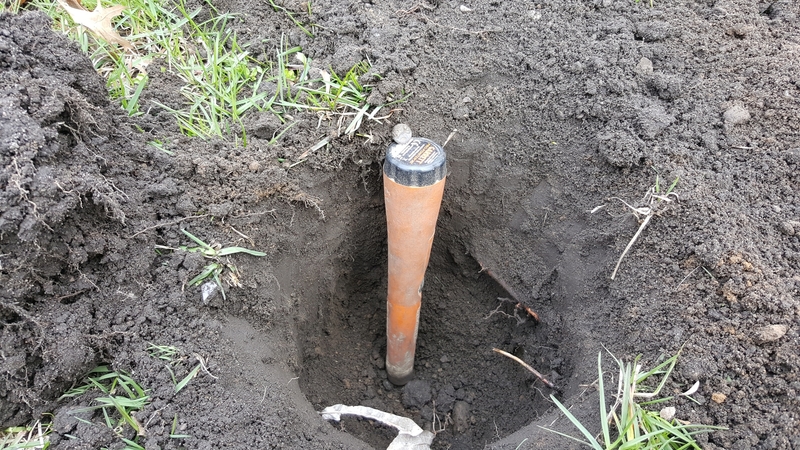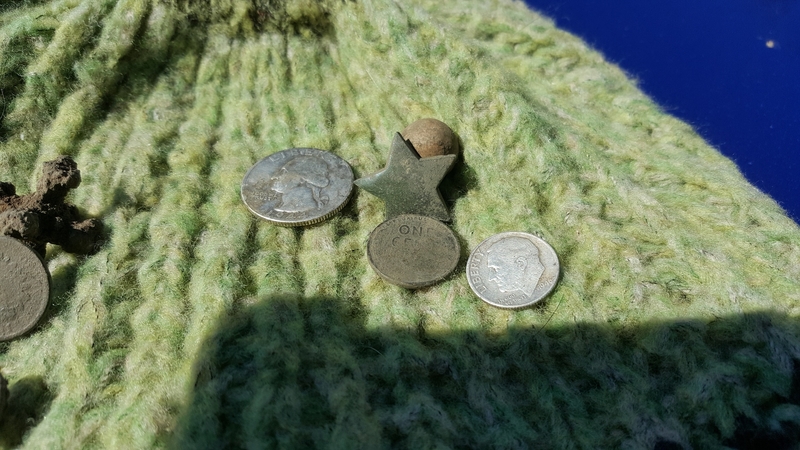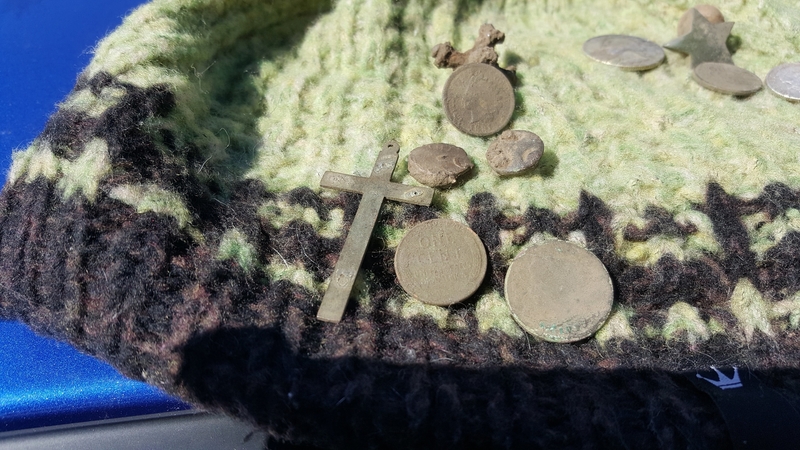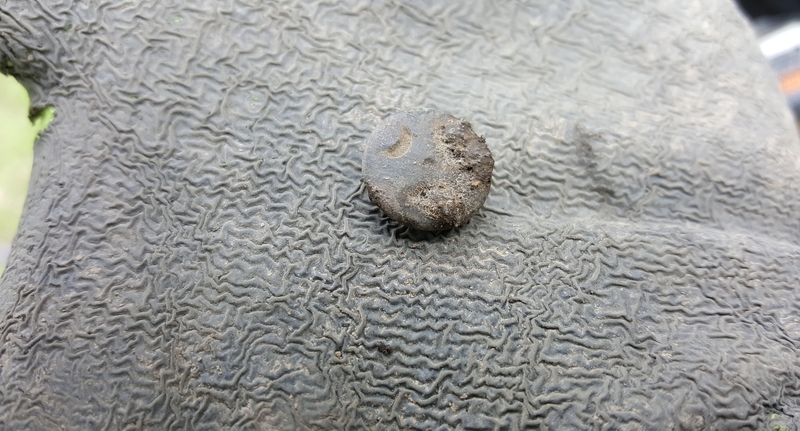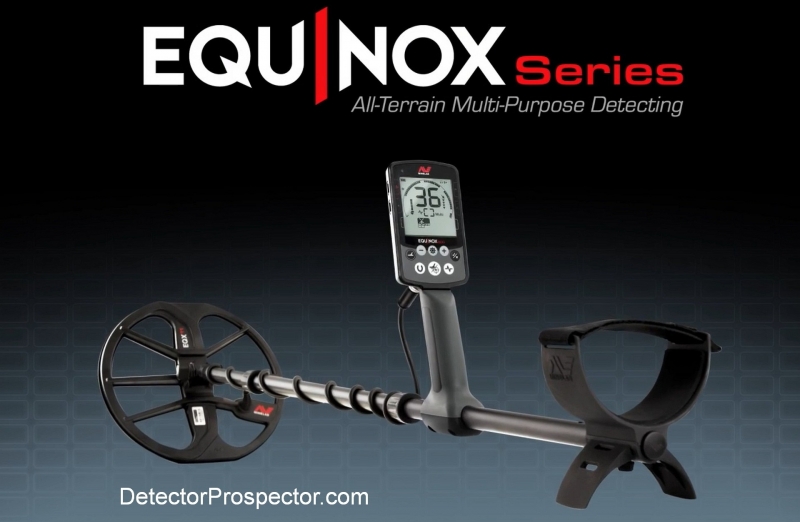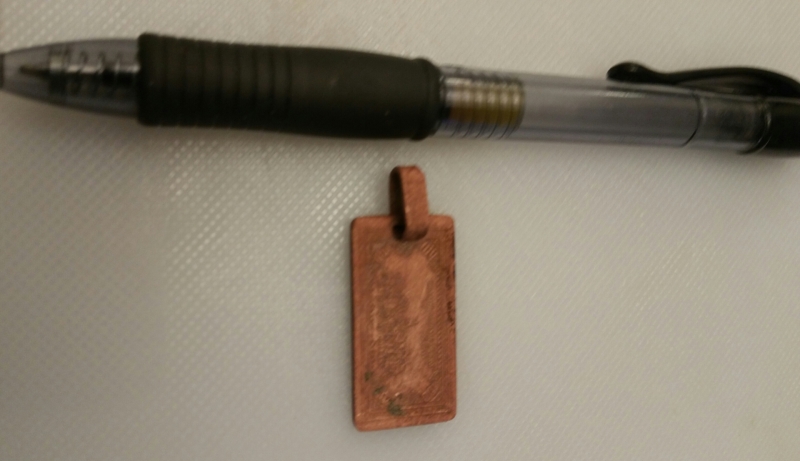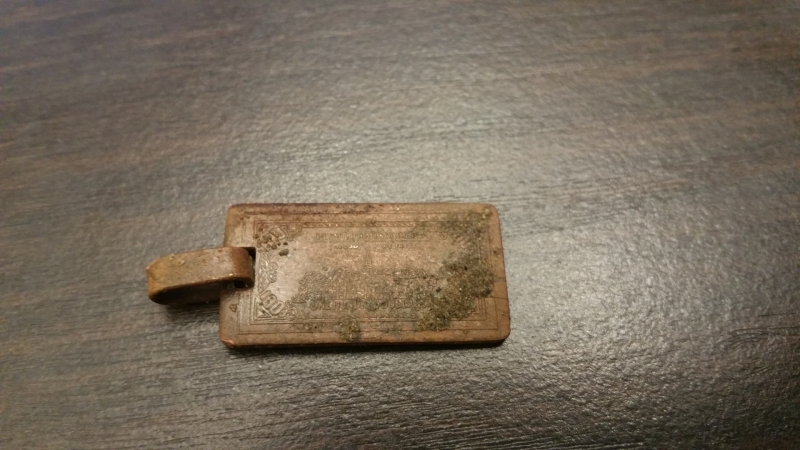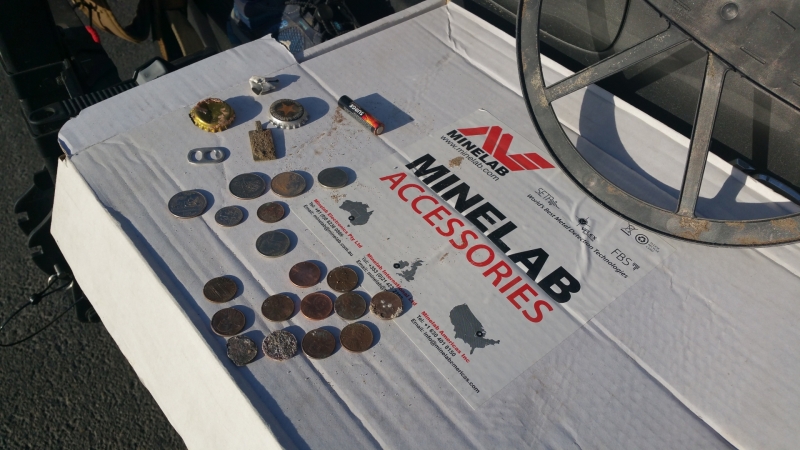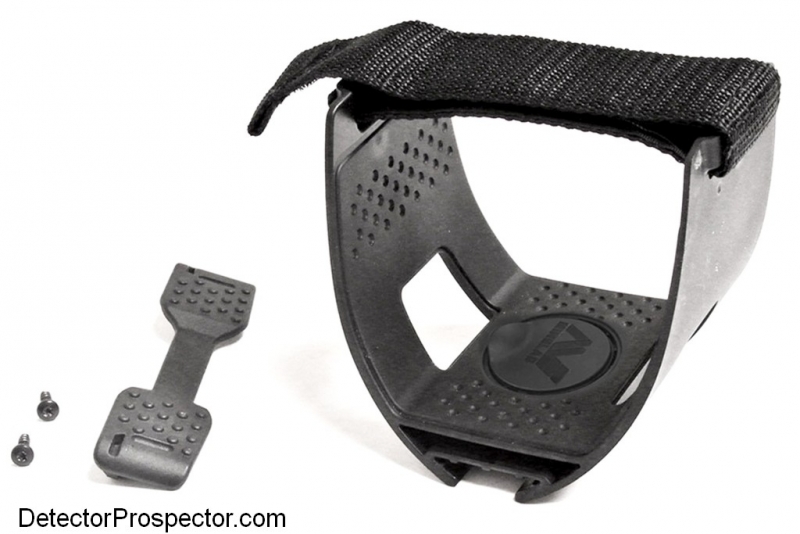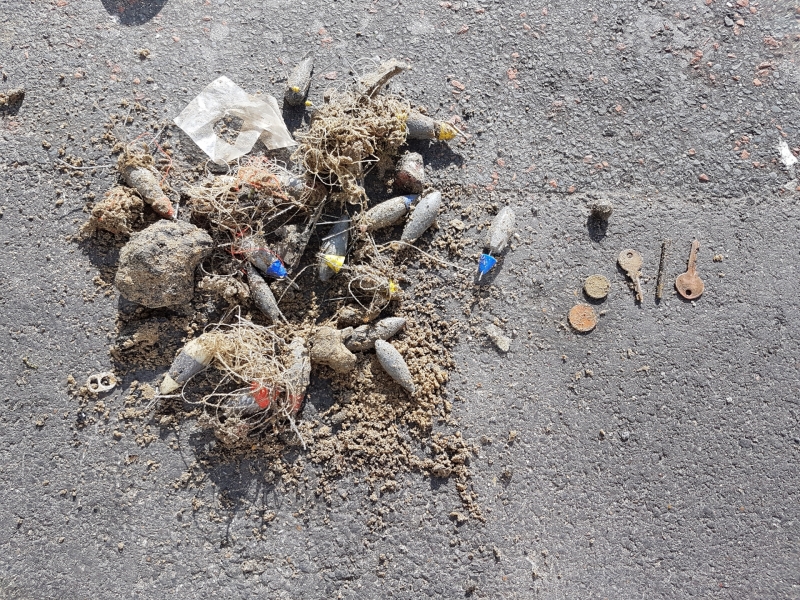Search the Community
Showing results for tags 'minelab ctx 3030'.
-
-
I went out with a friend who had just gone from the ATMax to the 800 and he wanted some help getting used to how the minelab spoke and some initial instruction on setup. I was most interested in seeing if I could get the sound attenuated like I did in my 3030 and having a hunter with me to call over for a "whisper" on my 3030 was most helpful. I was running a wide open screen manual 24, high trash, deep on, and rest off. I find a quite deep tone and have him come over and we dial back the sensitivity until it started to sound clean, but quiet. He was running park 2, GB 4, 50 tones, bias of 2, and recovery 5. We pulled the target and it was a deep brass? star at about 8.5". This park has given me tons of deep keepers so we pressed on. The next person to find a deep target was my friend, and he called me over. He turned off the wireless so I could hear it and he was tagging it good and it was coming in softly. It was undulating between 13 and 14. I was excited thinking it may be a deep nickle. I tried it on the 3030 and I couldnt get it. I bumped up sensitivity to where it started to get chatty and I dialed it back by 1 putting me at 26. I couldn't get it, not even a null. I tried going from high trash and fe-coin and ground-coin... Nothing. So he pin pointed it and I cut and popped the plug for him, I was too excited to stand and watch. I get the plug open, put the pointer in, and no hit. Plug was only 5" deep so I went further and I started to hear it with the pin-pointer. Here is a picture of what it was... I was gob-smacked... Small 2 piece button. I turned off the 3030 and retrieved my 800. We both got dialed in and it turned into a day of history retrieval from the park. What a fun day with a friend and had my best silver day in a park for a loooong time. His take was an 1889 V nickle 1891 IHC and some other fun stuff. I had a 46 Rosie, 44 Washington, a nice clay marble and some other odds and ends. Thanks for looking and may you find the treasures you are looking for!
-
Ever have one of those days not one stinking old coin just some assorted clad that was Saturday so I licked my wounds and went back Sunday so I finally got out to the fairgrounds to try out the nox . Sunday was better took the ctx and nox hunted with the nox the coins were 2 to 3 inches deep all had nails was running 7 for recovery speed park 1 iron bias The nox called the merc at 2 inches deep at 20 I had high tones set from 19 and up and nickels open at 12 to 13 the ctx called it iron except one sweep would give 12.43 more accurate ID than the 20 the nox called it but I don't think I would of hit it with the ctx it was a small window .The nox found the coin with every sweep at 20 there were nails with it had to bring down the ID because it could not separate it . The other 2 silvers came in at 26 and 21 both had nails with them ctx called 12.43 on one and iron on the other however it was a very small window to get a ID and only one way again . As far as nickels I am throwing in the towel the nox calls almost all tabs and a lot of caps 13s and 12s so I marked 10 solid 13s and 12s with the nox the ctx called them caps and pull-tabs one it called 12.13 which turned out to be a beaver tail which is one of the only things I dig or some tabs . Not like the nox which just loves to call everything nickels the only targets I marked were 12 to 13 maybe the 6 will work better don't know but I am done digging nickels with the 11 inch coil . It might find nickels deeper but not at a fairground unless I take up mining aluminum . I will still dig nickel signals but not at a cap and tab infested area with no depth reading to tell me how deep they are . If I get back to the fairgrounds I may just mark the nickel hit's with poker chips and rescan them all with the ctx save some digging .I will be running park 2 next time to see what the nickels well do but park 1 is not a nickel magnet at all . sube
-
Hi all! I wanted to share a real-world hunting report, from yesterday, at a local public park. I was hunting with my CTX and 17" coil; sensitivity manual 25, ferrous discrimination only, 50 tones, Ferrous-coin separation, deep off, fast off. My buddy was hunting his Equinox, Park 1, 23 sensitivity, recovery 5, iron bias 2, 50 tones, no disc. I was moving along slowly, and "hunting deep," and I hit a soft, repeatable high-tone that I figured was a coin -- around 12-39 to 12-41, so I figured wheat cent. Depth meter showed about 9"-10". I dug, and it was indeed an 8" to 8 1/2" deep 1920 wheat cent. I filled the hole, and started swinging again. A foot away, I hit a very similar signal, but this one just a bit less repeatable. There were a couple of angles where it was hard to get an audio signal on, maybe one out of every 3 or 4 passes I'd get a tone; most angles though, it was fairly repeatable, giving a good, soft high tone on 3 out every 4 sweeps. I could tell this one was nearer the depth limits of the CTX (at least in my dirt, for my skill level), and the depth meter was showing 10" to 11". Again, 12-39, 12-40 type reading. So, pretty sure I had another deep coin, as part of a "pocket spill," this time I called my buddy over to give a listen with his Equinox. He got a soft, entirely repeatable high tone as he rotated and "Minelab wiggled" the target, average ID readings in the mid 20s, right around 25. He guessed copper/wheat cent. So, I handed him the CTX to listen (he knew how to interpret the CTX, as his "other machine" that he's used for nearly 10 years is an E-Trac), and after working the target, he felt the CTX signal was similar to, or maybe not quite as good as, the Equinox. So, next, I listened to the target on the Equinox, and concurred. The signal was indeed a bit more consistent/repeatable on the Equinox as I worked the target. I dug it, and it was a 9" deep 1928-D wheat cent. So, I filled the hole, and started sweeping again. Less than a foot away, I got a repeatable-from-all-directions but inconsistent-sounding signal. I would NOT have dug this signal normally, as it would not have caught my attention if I were just "moving along, hunting normally." It was all over the place, audio-wise, ID numbers teens to mid 20s, more 20s than teens. BUT -- being less than a foot away from the two wheats I just dug, I was listening carefully for ANY repeatable tone, to see if there were any more coins -- and so I gave this one way more attention than I normally would have. That plus the fact that it was showing 8" to 10" on the depth meter, had me interested. Again, moving along hunting "regularly," and not scrutinizing every sound because of working a "pocket spill," the predominantly high teens and 20s ID numbers, and audio "all over the place," would NOT have caught my attention enough in this trashy park for me to stop to investigate. One final reason I was interested, was that I knew this is how a fringe-deep nickel behaves in my test garden. Consistently registers a tone from all angles, BUT nowhere near nickel ID (13 CO number), but instead generally upper teens and 20s conductive numbers. So, I called my buddy back over with his Equinox. I was almost sure he was going to get a very solid-reading, 12-13 IDing target, as I was almost sure it was going to be a deep nickel at this point, and I knew that lots of 12s, and a few 13s, is generally how my Equinox behaves on deep nickels. And that's exactly what he got. A solid, repeatable-from-all-directions 12-13 signal, with an occasional blip of 11, or 14. Mostly 12's. I let him listen on the CTX, and he said "wow, those tones are all over the place." I told him that that is why I dig few deep nickels with the CTX. He let me listen on the Equinox -- a perfectly diggable, easy-to-call nickel-type signal. So I dug it, and it was about an 8" deep Buffalo. Finally, about 5 minutes later, about 10 feet away from the other 3 coins, I got another deep, repeatable high tone. This one showed 8" to 10" deep, with mainly upper 30s to around 40 CO numbers. I called over my buddy, and it was the same as on the first wheat he listened to -- low to mid 20s, with an occasional higher ID, soft but solid and repeatable. I popped the plug on this one, and the numbers for me were now showing a bit lower -- 12-37s in the plug. At that point, reading a bit lower "in the plug" than it did in the ground, we both guessed Indian instead of wheatie. Sure enough, about an 8" deep 1898 Indian Head penny. My long-winded point in all of this, is to share a direct, in the field, head-to-head comparison of the Equinox to the CTX on three different, un-dug targets. This perfectly mirrors the results in my test garden, with the Equinox being just as deep, if not a tad bit more solid on each of the targets I have buried -- pennies, nickels, dimes, and quarters (with the largest advantage in the Equinox's favor showing up on the nickels, but still a small advantage on all the coins). This also mirrors most of the comments from other hunters who are posting results. It's for real, guys. While there are still things the CTX does better (such as providing better "dig decision" information, visually, in a much more thorough way, AND allowing you to avoid more trash, more easily), the Equinox is a very, very impressive performer. Just as deep if not a tad deeper, and a better hunter in trash/iron... Steve
-
This has been the subject of much debate and I thought I would weigh in with a little this versus that to help offer a little guidance. I think Minelab was caught off guard by all this because the whole conversation from their perspective was supposed to be about AT Max versus Deus versus Equinox. Yet the majority of the debate is about this Minelab versus that Minelab. I guess that is a credit to Minelab but at the end of the day I am not sure they are too worried about what Minelab you buy as long as it's a Minelab The Minelab Sovereign and the Excalibur introduced the world to Broad Band Spectrum (BBS) which was Minelabs term for their first generation multifrequency detectors. The Sovereign and the Excalibur are tone based detectors with no screen and so are for people who hunt by ear. They act like very low frequency detectors and because of this are very strong on silver coins. They also do relatively well on gold targets though they are weak on the smallest gold targets. They are very well behaved detectors that handle harsh saltwater environments well, making the Excalibur perhaps the most successful underwater detector made. The BBS detectors are strongly biased against ferrous targets and better ignore ferrous than any detector I have ever used. Ferrous is almost invisible to a BBS detector. This comes at a cost however. The processing speed is very slow and combined with the strong bias against ferrous target masking is a problem with these machines. That is not to say you cannot find targets in ferrous trash. You can. It is simply an area where BBS is very weak. The next generation introduced Full Band Spectrum (FBS). The Explorer, Safari, and E-Trac further refined BBS and without getting into details the big addition was a two dimensional target id display that locates items on screen with a combination of a ferrous number and a conductive number. This dual target id combined with a screen added more refined discrimination capability to a detector already very well suited to people that hunt by ear. Anyone talking about the Explorer and silver will usually mention the great tones it makes on silver. The frequency weighting is very much in favor of low conductors and the Explorer series became famous for the ability to extract silver coins from park type scenarios i.e. turf hunting. A faster processor speed improved the situation with masking in dense targets to a degree, but the FBS machines still lag single frequency detectors a lot in this regard. The FBS detectors again are excellent at identifying and rejecting ferrous targets. The Minelab CTX 3030 introduced FBS2 which further refined things. I am being purposefully over simplistic by saying the CTX mainly added an even faster processor, color screen, and the ability to be submerged to 10 feet. FBS2 appears to be a little hotter on small gold items but the main strengths are still in silver and in ferrous rejection. The color screen added new features like target trace that allow more than one target to be displayed at once for world class discrimination capability. The BBS/FBS series have been extremely popular around the world and are to this day. However, the detectors faced competition in three main areas. They are relatively expensive detectors and they are relatively heavy detectors. And even though they can find good targets in dense trash they also leave a lot behind due to the slow recovery speeds. The Garrett AT series was revolutionary in creating detectors waterproof to ten feet that only weigh about three pounds and at a price so low it really turned the market on its ear. These detectors have been immensely successful in creating a high value combination of features at a very low price and with decent performance. This combined with top notch marketing makes the Garrett AT series very popular especially in the United States. The XP DEUS came out of left field and in Europe took the market by storm. These detectors are both extremely light in weight and extremely fast in target response and recovery speed. These two factors alone mean that a detector rally in the U.K. will be almost nothing but Deus detectors with a smattering of other machines. Deus does also focus on low conductor performance, as the recent addition of high frequency coils reveals. Remember that small thin silver items like hammered silver and cut silver coins actually respond as low conductors. Minelab saw this happening but the truth is coin and relic machines are a far distant second when it comes to profits compared to the gold machines. Any company only has so many resources and the GPZ 7000 development in particular was a major lift even for Minelab. Still, the company knew it would have to address the situation with detectors that did exactly what the Garrett AT and XP Deus did, which was target BBS and FBS where they are weakest. Price, weight, recovery speed, and low conductor sensitivty. Equinox does all this while also adding the latest twist on their multifrequency technology; Multi-IQ. The intent here as Minelab has made clear was not to replace the BBS/FBS machines but to augment them with another line that is specifically better in areas where BBS/FBS fall short. Again, weight, price, recovery speed, and I am going to add sensitivity to small low conductors to that list. I had a CTX 3030 and loved it. Yet I rarely used it. Why? My type of detecting. BBS and FBS favor people who hunt high conductors and typically favor people who hunt in mild to moderate ground. I do just the opposite. I hunt low conductors, gold specifically, and in highly mineralized ground. It is hard for people who do not hunt highly mineralized ground to understand how much it impacts detector performance, but seeing overall VLF depths cut by 50% or more is not unusual. Target id also suffers a lot in bad ground as does target masking from hot rocks and the ground itself. I know a lot of BBS/FBS users have a hard time grasping this, but in my ground there is no major benefit to BBS/FBS except for the fantastic target id capability, especially as regards ferrous rejection. Depth is easily matched or exceeded by the best single frequency detectors, which however suffer in their own way with unreliable target id. And the fact is multifrequency has always been weak on gold - not even Minelab suggests that BBS/FBS machines should be used for gold prospecting, although people can and do find gold nuggets with them. Still, you can't beat BBS and FBS for being well behaved, easy to operate, and in having top notch target id combined with best of class ferrous rejection. Arguably the worlds best machines for hunting silver in turf. Everything in designing metal detectors comes in the form of a trade. When you gain one thing you tend to lose something else. In general putting the fine details of Multi-IQ aside I think the Equinox acts more like a single frequency machine in some ways than what people are used to from BBS/FBS detectors. In particular we have the lightning fast recovery speed and extreme sensitivity to low conductors. Multi-IQ put simplistically adds the target id accuracy that single frequency machines lack in bad ground. In my opinion people coming from hot VLF detectors will take to Equinox more easily than people coming from BBS/FBS detectors. I love hot VLF detectors for what I do so Equinox is a natural fit for me. The move from the more stable well behaved BBS/FBS machines is more jarring for people I think because they are stepping into another world - my world - where they are perhaps less comfortable. People who hunt low conductors, especially in bad ground, and those who hunt non-ferrous in bad ground know that the ferrous/non-ferrous divide is an area fraught with danger. Reject too much ferrous, and you lose the non-ferrous. It appears impossible with current technology to get a clean ferrous/non-ferrous separation. I mean honestly, all I want is a detector that beeps on non-ferrous and shuts up on ferrous and does it with near 100% accuracy. This would seem simple given the difference in magnetic properties between ferrous and non-ferrous targets, but to this day flat steel, washers, hardened steel bolts and screws, bent nails, nails on end, broken square nails, etc all present problems for all metal detectors. It is a huge fuzzy area, and in the end it appears we have to make an unpleasant trade. Equinox in targeting the BBS/FBS weaknesses regarding target masking and low conductor sensitivity is making this trade. The machine steps back in a way and favors those who hunt by ear. Most of the commentary I see about target id spread and the potential limitations there fly over my head because I prefer to hunt by ear with a wide open screen in 50 tones mode for general park and beach detecting. If you are a BBS/FBS hunter this should be familiar to you and yes, you get something pretty close to familiar Minelab tones with Equinox. For field hunting (relics) or nugget hunting in dense trash I am more likely to go to a two tone type mode just due to the sheer number of targets but two tones does make a person more susceptible to ferrous squeaks tricking you than 50 tones where the nuances are more apparent. There is no right or wrong here because people seriously do tolerate this kind of stuff to a largely varying degree and so to say 50 tones is a magic bullet is just plain wrong. We all have to find the balance that works for us personally. Just remember there is a reason many Deus users tell people to stick the controller in their pocket and forget about it. Deus and Equinox favor people who hunt by ear. I apologize if this oversimplifies things but that is what many people need right now. I am leaving price and weight off the considerations below and just talking performance. BBS - only current model the Excalibur. For people who hunt by ear, great in saltwater, great on silver, very good on gold, superb ferrous rejection. Main weakness slow recovery speed, target masking. Moderate depth in highly mineralized ground on low conductors. FBS - current models Safari and E-TRAC. Basically same as BBS with marginally improved recovery speed, main addition target id screen with dual ferrous/conductive id offering very high resolution discrimination. Great on silver, superb ferrous rejection. Main weakness slow recovery speed, target masking. Moderate depth in highly mineralized ground on low conductors. FBS2 - CTX 3030. Slightly improved recovery speed, slightly improved sensitivity to small gold, color screen, target trace. World class discrimination. Great on silver, superb ferrous rejection. Main weakness slow recovery speed, target masking. Moderate depth in highly mineralized ground on low conductors. Multi-IQ - Equinox. World class recovery speed, world class sensitivity to low conductors in mineralized ground. Very good on silver in highly mineralized ground. Weaknesses are less visual target id resolution compared to BBS/FBS, weaker on silver in low to moderate soils, ferrous handling more akin to hot VLF detectors than BBS/FBS detectors. Unknown yet but may exceed or at least match BBS/FBS in saltwater environments. Again, I am purposefully oversimplifying things here on purpose. People including myself have a tendency to wander into the weeds with this stuff and get lost in the fine details. The bottom line is BBS/FBS and Multi-IQ are complementary technologies, each strongest where the other is weakest. For a certain type of user (me) Multi-IQ does indeed replace BBS/FBS. In my ground and on my targets including silver I see no benefit at all to BBS/FBS except the ferrous handling. Yet I know that is the price I have to pay to get the performance I want. On the other hand, people hunting silver in lower to moderate ground conditions have the edge with BBS/FBS and if you hate digging any ferrous at all these machines are best of class in rejecting ferrous. I hope that helps. I have to note again in closing this was never really supposed to be about this Minelab versus that Minelab but when it comes down to it Minelab is really happy to have that discussion. Equinox was specifically designed to compete with the competition, not Minelabs own detectors. Maybe a future version of Multi-IQ will give us the best of BBS/FBS and Multi-IQ in one detector but for now both offer their own strengths and weaknesses. And while Multi-IQ as currently available in Equinox is not perfect, it would be crazy to ignore the weight and price issues. They matter - they matter a lot to some people. Equinox in my opinion offers bang for the buck value that cannot be ignored, and for that reason alone it is going to be a sales juggernaut no matter where our little online debates lead us. And for you who love BBS/FBS - nobody is taking them away from you. Go detecting, be happy! Disclaimer - all the above is just my outlook and personal opinions and do not represent Minelab in any way, shape, form, or fashion. It is based on my own experience plus reports coming in from other people that I trust but should still be considered preliminary information/opinions. Nobody including me is an Equinox expert yet and no doubt its use will be refined as more people share tips and tricks.
-
CTX Prospector - Published on Jan 16, 2018 Here I show you how to replace the batteries inside the Minelab CTX-3030's battery pack with new cells from Japan purchased on eBay for $15 bucks! Takes about an hour to carefully remove and replace the 4 cells. Works like the original $150 battery pack! Minelab CTX-3030 Battery Pack Part No. 3011-0299 Panasonic CGR18650CG 2250mAh Lithium-Ion Li-Ion Rechargeable Battery Cells Perform at your own RISK! Happy Hunting! - Jason CTX Prospector
-
https://www.minelab.com/usa/go-minelabbing/treasure-talk
-
A new Treasure Talk blog by Gary Drayton... The CTX 3030 Road Warrior
-
So far I only have 2 days detecting on the beach but coins are no problem. Learning how the audio tones and numbers work together. The 3030 is rather intuitive...I haven't had too much trouble so far just getting the coins etc. I can tell a screw top from a quarter...But I had to be careful when I tried to rule all of those tones as screw tops because I found a few nickels that were in the same number range .....and they also bounce around. I'm very new with it. Found about 2 dollars in change so far...in two short hunts. I did find a neat little 1.5 gm pendant that is rose gold....that I thought was junk. Just getting settled in here..look forward to more fun. Thanks Fred and I pray you are feeling better. Paul
-
I would like to respectfully request something that I am sure has been requested before... The option, on a CTX 3030, of running 50-tone conductive -- i.e., the full set of conductive tones -- in "combined" mode. Right now, of course, we can only choose four "non-ferrous" bins of tone, above the ferrous bin, in combined mode. Combined mode is such a GREAT idea -- but in my strong opinion it is HINDERED, unnecessarily, by forcing 50 possible conductive ID numbers into only four bins. I have ALWAYS hunted my Explorers in full multi-tone, and would LOVE the ability to run a "combined/full multi-tone" mode on the CTX. Could you PLEASE ask the engineers/software designers to place that option into a future CTX "software update?" I can't imagine it's any more than just some simple software coding to permit that option... Thanks for considering -- Steve
-
At one time before its release I had been interested in the Nokta Impact. Speculation ran rampant and I got sucked into the vortex. I already owned a Red Racer and a Gold Racer so I knew that Nokta/Makro made good detectors. As so often happens life intrudes on our metal detecting plans. In the last year I have not detected near as much as in years previous so I had shelved my interest in the Impact. Yet recently I have been able to detect more so I went ahead and acquired one. As usual, I first read the manual(what a geek). While the Impact is a more complex detector than either the Red or Gold Racer, the excellent menu tree and my perusal of the manual had me up and running in short order. At my first opportunity I took the Impact to a location that has had a serious pounding with the Deus, CTX, and who knows how many other detectors. I started detecting with the stock elliptical affixed to the stick. Although the Impact weighs about 4 Lbs. I thought it was nicely balanced so swinging it did not overly fatigue me. This machine has a mode for about any type of detecting you would want to do but on my 1st day I only tried 4 of them. GEN D, DI99, DI4, and VLX2. After a couple hours trying the different modes and learning the tones on the Impact I had found some non-ferrous items that were missed by all other machines but nothing that was a keeper, mainly miscellaneous bits of brass and copper. I thought it was time to switch gears so I threw on the 7" elliptical. I had previously been running mainly factory presets in the various modes but with this coil I wanted to gain back some of the depth I knew I would lose with the smaller coil so I bumped the sensitivity up. I worried about increased EMI but with this coil running hotter, EMI did not cause me any problems. I really like this tiny elliptical. It's the perfect size for working in the iron while still getting more coverage than a 5" or 6" round. I took this little football coil into the heaviest iron at the site and once again while I was able to pluck some non-ferrous targets out of that mess I found nothing to write home about(story of my life, LOL). I did try out the 15" coil. Honestly I am not a big coil guy unless I am swinging a PI and going for max depth. I love working in the iron with VLF's so usually a small coil is welded to the dirt end of whatever machine I am swinging at the time.This 15" is a coil I would use for very specific circumstances only as I would need to wear a harness if I was going to swing it very long. With the 15" mounted up to this machine it was very nose heavy and my arm hurt in no time at all. The wireless headphones seemed to work well. I did not notice any lag that would affect target recovery. A few times I thought I detected the slightest lag in heavy iron, but it was near the end of the day and honestly I was getting tired and probably a little cranky. Likely my imagination. At the end of my first day with the Nokta Impact I was favorably impressed with most aspects of the machine. My main gripes were 1) while well balanced it is still 4 Lbs. I am used to a Deus so when you grab this detector you wonder why it can't be lighter. 2) The tones are very digitized sounding. Some people may love these tones, me not so much. 3) The wireless headphones do not have a long enough adjustment band for me to wear them comfortably with a baseball cap. They rode up on my ears and irritated me. A few days later I decided to do a shoot out between the Impact and some other detectors I have to see how they performed with iron masking. This test was not done to rigorous scientific standards. LOL. Just a test I did for my own information. I can't post all the individual settings and results. I had to come to work on a tugboat and I forgot and left all my notes at home. I will give a quick synopsis of my findings. I hope some one finds it useful but it is just my own opinion. Others are likely to have different results. My friend Chuck(Strick) will post photos of the test for me because he is a good guy and has that down pat. The machines tested were; CTX 3030 with 6"R coil. Red Racer with OOR coil. Deus with 9" LF coil. Deus with Elliptical HF coil. Impact with 4x7" coil. I made sure the dirt was clean of targets befor flipping over a rubber welcome mat and inserting a 1926 SLQ and a 1855 seated dime into holes in the backing. I did this so the square nails I placed near the coins were slightly elevated over the coins. I manual GBed all the machines except the CTX. The dirt under the mat is kinda hot. It lights up most of the bars on the Deus FE meter. The results of the test were surprising to me. First that the CTX did so well in comparison to most of the other detectors. On the first scenario( quarter with one small square nail and one big square nail), all the detectors except the Deus with HF coil could generate a diggable signal on 25% +/- of angles swung on the target. The Deus with HF coil could get a diggable signal 360 degrees around the target. On the second scenario(dime with 3 nails), all the detectors except the Deus with HF coil could not generate a diggable signal from any angle swung. The Deus with HF coil could generate a signal 360 degrees around the target. As I said before I was a little shocked the CTX did so well in the quarter test scenario compared to most of the other detectors because I have seen the Red Racer, and Deus HF and LF coils eat it alive when comparing signals on live relic digs on un-dug targets in heavy iron. I thought the Red Racer would do better as I have also seen situations in which the little OOR coil on the Red Racer seemed almost magical on targets the Deus LF and other detectors have failed on. As far as the Impact is concerned I felt its performance in these two scenarios on that day in that dirt was was nothing to write home about but to be fair it did as well as any detector besides the Deus with HF coil. I was hoping for more as far as separation/unmasking ability from this detector with the 7" coil onboard. But I must say that a detectorist that I respect very much and I believe is a straight shooter tells me the Impact with 7" coil does beat the Deus with HF coil in some scenarios. Anyway, on that day in those two scenarios the Deus with HF coil spanked all the others. I am sure other detectorists will have different opinions or results and that is fine by me. I don't own stock in any of the companies manufacturing these machines. In summation I would say I do like the Impact. It has many fine features and I know I need way more hours on it to leverage all of its capabilities to my advantage. In my world the CTX is my park and lawn machine. The Deus with the HF coil has become my main relic machine for heavy iron. I love the Deus for its light weight, speed, and versatility. But now there is a new kid in town- the Impact. LOL . When I get time I know I will enjoy learning the nuances of this machine. I am looking forward to spending more time in the all-metal modes and some of the other modes I haven't explored yet, like Deep mode.
- 9 replies
-
- 7
-

-
- minelab ctx 3030
- nokta impact
-
(and 1 more)
Tagged with:
-
I've had one since they came out and 2 years ago it was standing there all sorry looking in the corner collecting dust. So I sold it. Guy who bought wasn't all that happy with it, Minelabs have a tendency to bash your ears if you let it. Guy couldn't handle the 50 tones. Ah well. But not having a CTX and all this talk about obsoleting this and that. Saw a nice CTX with a few miles on the skidplate looking for a second home. UPS guy delivered and a day at the beach was on the cards. This thing is the real deal, no questions asked. Just a lot of awesome RAW detecting power. Swings like a perfectly balanced boat anchor. Boy does it love high conductors. My settings for a moist windblown autumn beach. DEEP ON, LOW trash, Manual GB, Auto sens, 2 tones Ferrous with above 31 ringing Hightone. No need to complicate things. Treshold just below audible, Audio Gain at 5, etc. etc. This beach has seen hunters all summer long, so pulltabs, bottlecaps, foil galore. High conductors are just about gone. But there I was digging coins 2 scoops down on a windswept chilly autumn beach with a smile on my face like Garfield. Got a ring as well, just a shame it was a small little tire-valve nut. Thx Mr Herschbach, You really made my day. Thx Mr Minelab, You do know how to make the magic flow.
-
Can anyone please direct me how to download the gold codes I can not seem to download it successfully for ctx3030
-
Steve, How is the XP Deus working for you? Is it really a worthwile addition for a CTX owner with small 6" smart coil for unmasking? I tried the Nokta Relic. I wanted to like it but too many false signals had me digging tons of trash. Some iron gives high signals even just 2 inches down in my dirt, out of the hole it goes low signal. I don't have time for that. Coins go into the upper nineties for target ID so a nail & coin look the same. I understand it's different in other States with milder soil. I finally bought a new CTX instead. These machines work here! I never seem to be able to get away from a Minelab. (Fisher has been good as well. Accurate target ID) -Don
-
Ron (CA) has shown at http://www.detectorprospector.com/forum/topic/292-minelab-ctx-3030-finds-25-ounce-gold-nugget/ what should be obvious - the Minelab CTX 3030 can find large gold nuggets. Lately, I have been getting very interested again in just what detectors would serve me best hunting mineralized nail infested tailing piles looking for gold nuggets. The Minelab PI detectors and Garrett ATX have limited ability to identify ferrous stuff but both fail at depth and when the trash gets really thick. So a VLF is still needed for some situations. The Minelab CTX is not particularly hot on small gold but it is exceptionally quiet on nails and other ferrous stuff that produce high tone false signals on other VLF detectors. This also makes the Minelab multi-frequency units more prone to masking, but that is less an issue in tailing piles than around a cabin site. Which is why I found this video of the CTX and the new Coiltek 10" x 5" DD interesting. It would be a good nugget coil for the CTX, but the $369 price tag is unfortunately quite steep. I may have to make do with my Minelab coils for now, but if the CTX proves out for me this coil may be a future acquisition.
-
Enjoy RR
-
This only fits the newer Minelab CTX 3030 and all GPZ 7000 units. Most people like me probably only want a replacement stand but for $15.00 with free shipping it is hard to complain. Except about the stand being so flimsy in the first place! Minelab Kit part #3011-0283 https://store.minelab.com/product-p/3011-0283.htm
-
Glad to see this. https://metaldetectingforum.com/showthread.php?p=2760349#post2760349
-
Aloha i decided to hit the beach again this week did 2 session 1 of 3 hours at night and 1 of 2 hours the day after i start to have fun with the CTX no gold yet but i found most of the fishing wet at 1 foot and more laying on a hard clay layer sand was mixide with large stone i think i would have struggled with a sand scoop big time ....i am gonna keep using spade till i find a sandy beach total 1 british pound and 2 pence i guess there was no fresh gold.... RR
-
"For some time now I have been keen to get my hands on one of Minelab’s CTX 06 six-inch coils for my CTX 3030. Recently, I finally bought one and couldn’t wait to get out and try it on some trashy sites that I have had success on in the past." Nice blog entry by Mike Gerlach at http://www.minelab.com/anz/go-minelabbing/treasure-talk/good-things-come-in-small-packages-detecting-with-the-minelab-ctx-06-coil
-
Went to the coast this weekend did try my luck on once a popular spot, i was using my CTX for the first time and i max out everything machine was stable but i found jacks£$t!!! I could feel that the machine is going deep but the spade i brought with me had a shaft which i didn't trust that much so i left a lot of target found 1 rivet 1 screw tap and 1 rusty piece of something.....the machine indicated target at 12" but i could reach them without breaking my spade and i had no spare.......well next time i will bring either a sand scoop or a better designed spade.. RR
-
I got a CTX 3030 for Christmas and left home for some better weather. I got my 3030 out for the first time at a club coin hunt a little over a week ago. I got it out for the second time today to detect a beach at a State Park beach. After about fifteen minutes, I started to hear a sound like a jack hammer. I stopped and took my headphones off thinking there must be a maintenance crew close by. The noise was gone. The noise was coming from the detector. I restarted the detector and from then on it would never go past the start up screen and no sound coming from the machine. I have a second battery and the 17" coil. I changed both and still would not go past start up screen. I am a thousand miles from home, my warranty info and the box it came in. Any thoughts out there? Sending off to a repair facility not knowing where I will be or when it might get repaired or replaced is not the option I am looking for. Norm McQ
-
So i decided to treat myself but not for any particular reason :) so i got myself a used CTX with 3 coils.......the wireless module, complete protection ,brand new XP back headphones but no charger :( , also got an xterra gold pack on his way used also but after swapping some gear with a friend and 13" detect coil for my Gbug....and i think thats all,no ...i forgot a headhunter pulse i bought and left to a friend who never used it ........i think i got enough gear for a while..... RR


